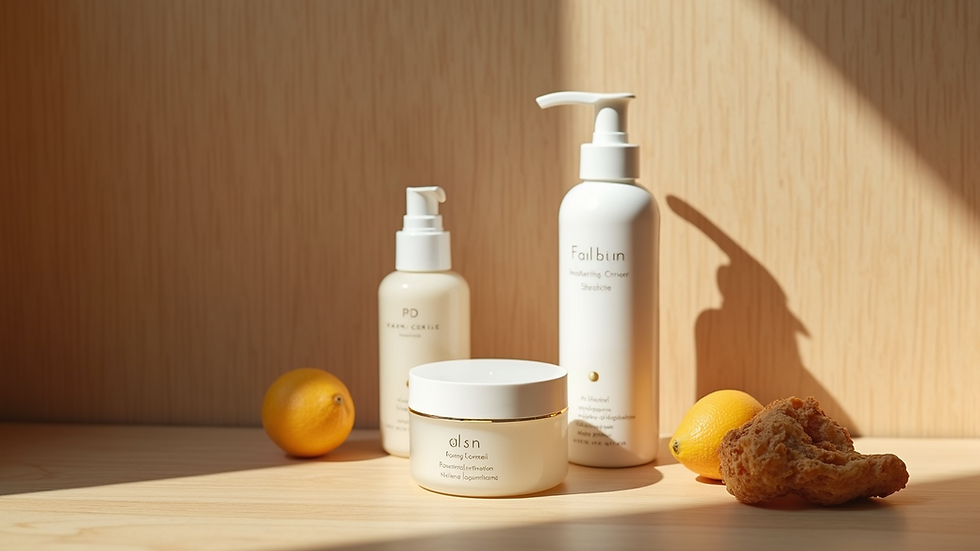How to Build a Simple and Effective Skincare Routine
- ifskincouldtalk

- May 27
- 4 min read
Building a simple and effective skincare routine can feel overwhelming, especially with so many products and trends on the market. However, creating a routine that works for you doesn't have to be complicated. By focusing on a few essential steps and reliable products, you can achieve healthy, glowing skin. In this post, we will explore the key components of a skincare routine, practical tips, and the much-talked-about "4 2 4 rule" in skincare.
Essential Elements of Your Skincare Routine
A basic skincare routine generally includes cleansing, toning, moisturizing, and protecting your skin. The exact products you choose will depend on your skin type, concerns, and personal preferences. Here’s a closer look at each step:
1. Cleansing
The first step in any skincare routine is cleansing. This helps remove dirt, oil, and impurities from the skin’s surface, allowing other products to penetrate more effectively. Choose a gentle cleanser that suits your skin type—cream or oil-based cleansers work well for dry skin, while gel or foaming cleansers are better for oily or combination skin.
Tip: Cleanse your face twice daily—once in the morning and once before bed. Remember to use lukewarm water, as hot water can strip your skin of essential oils.

2. Toning
After cleansing, the next step is toning. Toners help restore your skin’s pH balance and remove any leftover impurities. Some toners also provide additional benefits, such as hydration or exfoliation. Look for alcohol-free options that contain hydrating ingredients like aloe vera or glycerin.
Tip: Use a cotton pad to apply toner evenly across your face or spritz it on as a refreshing mist throughout the day.
3. What is the 4 2 4 rule in skincare?
The 4 2 4 rule in skincare is a unique cleansing method that enhances your skincare routine. Here’s how it works:
4 minutes of cleansing: Start with 4 minutes of deep cleansing using a two-in-one oil or balm. This helps dissolve makeup and impurities.
2 minutes of lathering: Next, spend 2 minutes lathering with a foaming or gel cleanser. This step thoroughly cleanses and preps your skin for hydration.
4 minutes of rinsing: Finally, spend 4 minutes rinsing with lukewarm water. This step ensures all product is removed.
This method encourages thorough cleansing and might be especially useful for individuals who wear a lot of makeup or have oily skin.

4. Moisturizing
Moisturizing is crucial, regardless of your skin type. A good moisturizer helps to hydrate and lock in moisture, ensuring your skin remains supple and healthy. For oily skin, consider a lightweight, oil-free gel. For dry skin, a rich cream with ingredients like ceramides or hyaluronic acid can make a significant difference.
Tip: Apply your moisturizer both in the morning and at night to maintain skin hydration.

5. Sun Protection
The last step in your daily skincare routine should always involve sun protection, even on cloudy days! Sunscreen protects your skin from harmful UV rays that can cause premature aging and skin cancer. Look for a broad-spectrum SPF of at least 30 and ensure it’s suited for your skin type.
Tip: Reapply your sunscreen every two hours if you are outdoors, especially if swimming or sweating.
Choosing the Right Products for Your Skin Type
Selecting the right products can make a world of difference in your skincare routine. Start by identifying your skin type:
Oily skin: Look for gel-based cleansers, oil-free moisturizers, and non-comedogenic sunscreen.
Dry skin: Opt for creamy cleansers, hydrating toners, and rich moisturizers.
Combination skin: You may need to use different products on varying areas of your face.
Sensitive skin: Choose fragrance-free and hypoallergenic products to minimize irritation.
Assessing Your Skin Needs
Beyond your skin type, consider any specific skin concerns you have, such as acne, pigmentation, or aging. Ingredients to look for include:
Salicylic acid for acne-prone skin.
Retinol for anti-aging benefits.
Vitamin C for brightening and even skin tone.
Building Consistency in Your Routine
Building a simple and effective skincare routine is not just about the products you use but also about consistency. Here are some practical tips to help you maintain your routine:
Stick to a schedule: Try to do your skincare routine at the same time each day.
Limit the number of products: Start with a few essential products and gradually incorporate others based on your skin's needs.
Listen to your skin: Keep an eye on how your skin reacts and adjust your routine as necessary.
Final Thoughts on Your Skincare Journey
Establishing a simple and effective skincare routine can significantly improve your skin’s health and appearance. Remember to keep it tailored to your skin type and concerns while ensuring consistency. With the right commitment and products, you will be well on your way to achieving radiant skin.
For a more in-depth understanding of skincare, feel free to explore more about skin care.
Maintaining your skincare routine may seem daunting at first, but with practice, it can turn into a straightforward and rewarding habit that leaves your skin looking healthy and vibrant. You deserve to feel confident in your skin, and building a simple routine is the first step toward achieving that goal.



Comments